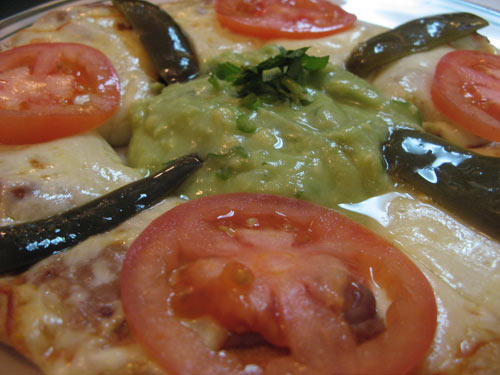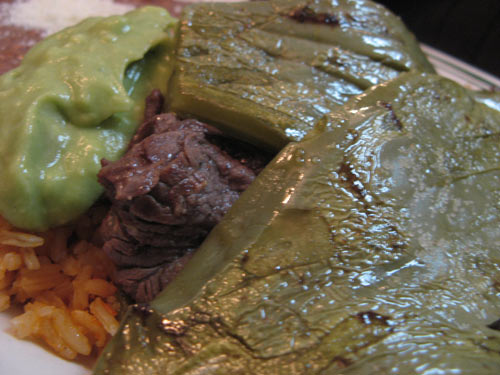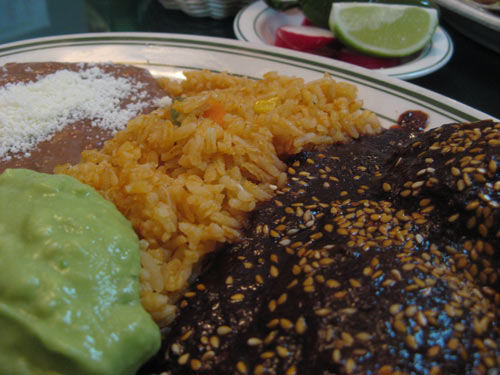Day: December 1st, 2006
Tulcingo Del Valle
B joined me in tonight’s dinner adventure, deep into the heart of Hells Kitchen. I’d first read about Del Valle in The New York Times a couple of years ago, shortly after its transformation from “glorified deli into modest restaurant.” I was intrigued by the “hopelessly traditional” husband-and-wife-run restaurant, with a 203-item menu and a chalkboard offering house specialties like chicharrón (fatty pork skin) braised in salsa verde and barbacoa (roasted goat meats.)
We headed West from B’s office at the Crossroads of the World to a stretch of block that seemed relatively untouched by the rapid gentrification/commercialization in the area: one unassuming restaurant among a small crop of eateries with very modest surroundings. There are, in fact, two Mexican places of note on the same block — the other being Tehuitzingo, which is the slightly more downscale of the two, comprised of a few stools at the rear of a narrow bodega.
Tulcingo Del Valle — somewhere along the way, the restaurant was rechristened to better reflect the town in Puebla for which it’s named — has a huge menu of simple, classic Mexican lunch-counter food. Their tacos and tortas come highly recommended, as do their moles; Robert Sietsema waxed on rhapsodically about their “extremely delicious” mole pipian of pumpkin seeds and tomatillos in his 2004 review. New York granted Tulcingo del Valle three stars status, and the #27 spot on their oft-referenced (on this blog) 2006 Best Cheap Eats list.
We started off with horchata (not “hot chocolate”), XX and a plate of the nachos, topped with cheese, tomato, jalapenos and some pretty standard guacamole, as we considered our entree options.

B ordered the carne asada con nopales (grilled beef with prickly pear cactus), which earned him an approving smile and giggles from our server. The nopal cactus is one of Puebla’s most important crops; every April, the central Mexican village of Tlaxcalancingo celebrates the Festival de Nopales in tribute.
Such generous portions! The dusky green paddles — spines removed, of course — arrived flopped over the meat, rice and refried beans piled onto the plate. The taste? Mildly vegetal — similar to green beans — with the unctuous texture of aloe or okra, but with a crisper core.

From the specials board, I picked out the mole poblano — signature sauce of Puebla — served with chicken. The platter arrived with tender pieces of meat, swimming under rich, dark, reddish-brown sauce topped with sesame seeds, and accompanied by thick, warm homemade tortillas.
Mole is derived from the Nahuatl mulli, meaning “concoction” or “sauce.” Culinary anthropologists note that very few of the spices in mole poblano are indigenous to the New World; the sauce, is in fact, born in part out of Spanish colonialism, which was an imposing force on the cuisine of Mexico. In Puebla, several convents were active in creating dishes that modified traditional recipes to suit colonial tastes, comingling ingredients from both the indigenous Indian and Spanish cultures. Among the regions of Mexico, there are variations on mole type and color (red, green, brown, yellow), but the mixture is at its essence a puréed combination of chiles and ingredients such as fruits, vegetables, herbs and spices, thickened with some combination of seeds, nuts, bread, masa and corn tortillas. The traditional poblano also contains Mexican chocolate, and can require dozens of ingredients and many hours to make.
The sheer effort involved makes me grateful for places like Tulcingo Del Valle, whose version of this dish is one of the best I’ve tried in the city.

B and I emerged from the restaurant into a downpour on Tenth Avenue. I thought wistfully of my umbrella, hanging uselessly on the coatrack in my office downtown. We huddled under a leaky awning and assessed our options: the IRT seemed too far away; the bus, too unreliable. We hailed a cab — fare hike or no.
Of course, moments after we shut the taxi doors behind us, the rains stopped.
Search
Popular Tags
Categories
Archive
- July 2010
- July 2009
- January 2009
- November 2008
- September 2008
- August 2008
- July 2008
- June 2008
- May 2008
- April 2008
- March 2008
- February 2008
- January 2008
- December 2007
- November 2007
- October 2007
- September 2007
- August 2007
- July 2007
- June 2007
- May 2007
- April 2007
- March 2007
- February 2007
- January 2007
- December 2006
- November 2006
- October 2006
- September 2006
- August 2006
- July 2006
- June 2006